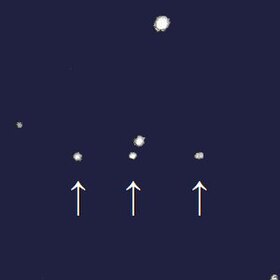Themisto (moon)
Outer moon of Jupiter From Wikipedia, the free encyclopedia
Themisto (/θəˈmɪstoʊ/), also known as Jupiter XVIII, is a small prograde irregular satellite of Jupiter. It was discovered in 1975, subsequently lost, and rediscovered in 2000.
 Rediscovery images of Themisto taken by the UH88 telescope in November 2000 | |
| Discovery[1][2] | |
|---|---|
| Discovered by | Charles T. Kowal (1975) Elizabeth P. Roemer (1975) Scott S. Sheppard (2000) David C. Jewitt (2000) Yanga R. Fernández (2000) Eugene A. Magnier (2000) |
| Discovery site | Palomar Observatory Mauna Kea Observatory (rediscovery) |
| Discovery date | 30 September 1975 21 November 2000 (rediscovery) |
| Designations | |
Designation | Jupiter XVIII |
| Pronunciation | /θəˈmɪstoʊ/[3] |
Named after | Θεμιστώ Themistō |
| S/2000 J 1 S/1975 J 1 | |
| Adjectives | Themistoan /θɛməˈstoʊ.ən/[4] Themistoian /θɛməˈstoʊ.iən/ |
| Orbital characteristics[5] | |
| Epoch 23 March 2018 (JD 2458200.5) | |
| Observation arc | 42.54 yr (15,536 days) |
| 0.0494401 AU (7,396,130 km) | |
| Eccentricity | 0.2522112 |
| +129.95 d | |
| 2.39396° | |
| 2° 46m 13.369s / day | |
| Inclination | 45.28121° (to ecliptic) |
| 192.64162° | |
| 241.25168° | |
| Satellite of | Jupiter |
| Group | (own group) |
| Physical characteristics | |
| 9 km[6] 16.4 km[7] | |
| Albedo | 0.04 (assumed) |
| 21.0[6] | |
| 12.9[5] 13.06±0.34 (V)[7] | |
Discovery and naming

Themisto was first discovered by Charles T. Kowal and Elizabeth Roemer on 30 September 1975, reported on 3 October 1975,[1] and designated S/1975 J 1. However, not enough observations were made to establish an orbit and it was subsequently lost.
Then, on 21 November 2000, a seemingly new satellite was discovered by Scott S. Sheppard, David C. Jewitt, Yanga R. Fernández and Eugene A. Magnier and was designated S/2000 J 1. It was soon confirmed from computing the past trajectory of the satellite that this was the same as the one observed in 1975.[2] This observation was immediately correlated with an earlier observation on 6 August 2000 by the team of Brett J. Gladman, John J. Kavelaars, Jean-Marc Petit, Hans Scholl, Matthew J. Holman, Brian G. Marsden, Philip D. Nicholson and Joseph A. Burns, which was reported to the Minor Planet Center but not published as an IAU Circular (IAUC).[8]
In October 2002, it was officially named after Themisto,[9] daughter of the river god Inachus and lover of Zeus (Jupiter) in Greek mythology.
Characteristics

Themisto's orbit is unusual: unlike most of Jupiter's moons, which orbit in distinct groups, Themisto orbits alone. The moon is located midway between the Galilean moons and the first group of prograde irregular moons, the Himalia group.
Themisto is about 9 km (5.6 mi) in diameter (assuming an albedo of 0.04).[6] While its true albedo could not be measured by NEOWISE due to poor timing of observations,[10] it is known to have color index B−V=0.83, V−R=0.46, and V−I=0.94.[11]
References
External links
Wikiwand - on
Seamless Wikipedia browsing. On steroids.
